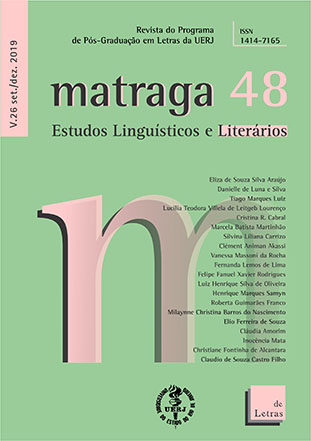“Here is the house”: A reading of the house(s) in The bluest eye, by Toni Morrison
DOI:
https://doi.org/10.12957/matraga.2019.41284Keywords:
Toni Morrison. Afro-American Literature. Social status.Abstract
In the present article we propose a reading of space in The bluest eye, by Toni Morrison, as a motif for plot and character development. The narrative takes place in Lorraine, Ohio, also hometown to Morrison. Other biographical elements appear in the narrative, the spatial being of utmost importance to this study. We explore the novel’s houses as spatial elements that add to characters’ subjectivities and embed the underlying theme of class. The narrative, which tells not only the story of Pecola, the protagonist, but gives us a detailed account of the lives of her mother, father, host family and community, starts with a simple description of a house as a place where a family lives and where everything comes together in harmony. This is done through the presentation of a primer which depicts language used in Dick and Jane books, texts historically used to initiate kids in reading. Such reference also implicates the representation of a perfect white suburban family where everyone gets along. Houses, furniture, backyards and other home-related elements foreshadow the unfortunate events to unravel in Pecola’s life along the novel. In terms of their significance in a broader perspective, we grasp that houses are in the novel also to set and depict the families’ background and current conditions in terms of class. Not only do houses help reinforce character traits, they stand as a social criticism to the economic conditions of blacks, also determined by whether their skin is darker or has a lighter shade.
---
Original in English.
Downloads
Downloads
Published
How to Cite
Issue
Section
License
Authorization
Matraga – Scientific Journal of the Post-graduate Program in Arts and Humanities of UERJ is authorized to publish the article submitted here, if it is accepted for online publication. It is attested that the contribution is original, that it is not being submitted to another publisher for publication, and that this statement is the expression of truth.
The works published in Matraga's virtual space – Scientific Journal of the Post-graduate Program in Arts and Humanities of UERJ will be automatically transferred, and your copyright is reserved to Matraga. Its reproduction, in whole or in part, is conditional on the citation of the authors and the data of the publication.

Matraga uses license Creative Commons - Attribution-Non-Commercial 4.0 International.





